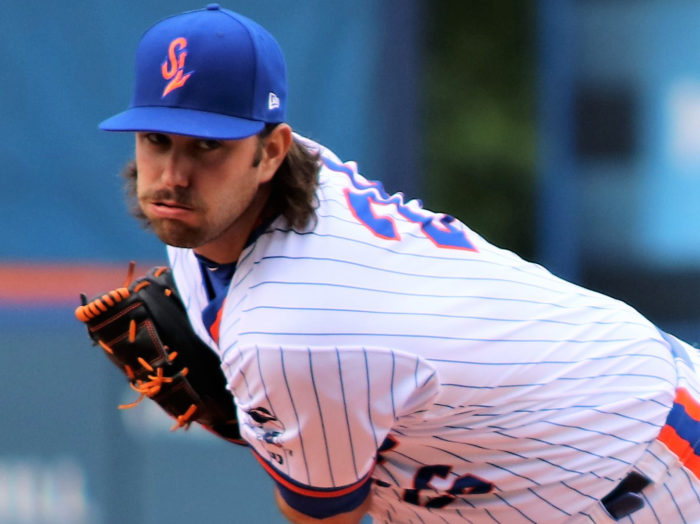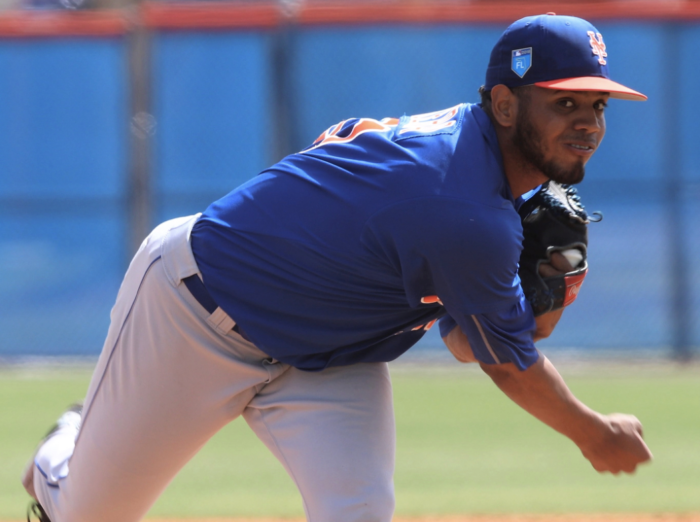
David Peterson/Photo by Ed Delany, MMN
For these selections, we voted among all the MMN writers with the criteria of performance in 2018 as well as current prospect standing.
Full Season Pitcher of the Year: David Peterson
With the recent trade of top pitching prospect Justin Dunn and the relatively weak upper level pitching depth in the Mets farm system, David Peterson was a fairly easily pick for Pitcher of the Year. The 6’6″ lefty was drafted with the 20th overall pick of the 2017 draft out of the University of Oregon and made a brief 3.2 inning cameo with the Brooklyn Cyclones to close out the 2017 season.
Peterson’s first full professional season got off to a slightly delayed start, as Peterson was dealing with a minor injury in spring training and didn’t make his first start until April 18. Peterson was initially assigned to the Single-A Columbia Fireflies, which seemed like a conservative assignment for an advanced college pitcher. By June, after nine starts with a 1.82 ERA and 2.53 FIP, it was clear that Peterson was too advanced for the level and he was promoted to the Advanced-A St. Lucie Mets.
In St. Lucie, Peterson faced his first real test as a professional player and experienced some major struggles over his first couple months at the level. He battled through a dead arm period and the results were quite poor. However, despite his unsightly 7.03 ERA through his first eight starts at St. Lucie, his 3.86 FIP and .385 BABIP indicated that better results were just around the corner. And, sure enough, Peterson concluded his season with one of the most dominant stretches of pitching in the Mets minors in 2018: a 0.62 ERA, 1.79 FIP, and 6.4 K:BB ratio over his last 5 starts. Peterson concluded his season by going 23.2 innings without allowing an earned run.
While his season had its low points, Peterson’s overall numbers for the season are quite impressive. Between Columbia and St. Lucie, Peterson had a 3.16 ERA, 2.77 FIP, 1.17 WHIP, and 3.83 K:BB ratio over 128.0 innings. Among minor league pitchers who threw at least 100 innings, Peterson’s 0.14 HR/9 was fourth best and his 64.5% ground ball rate was third best, indicating an exceptional ability to keep the ball on the ground and in the ballpark. Peterson was also chosen as the Mets Sterling Award winner for the Columbia Fireflies.
Peterson’s fastball sits in the low 90s, topping out at 95, and has heavy sink, which is hard to barrel up and results in a large number of groundballs. There is debate whether his change-up or his slider is his best secondary pitch, but both are considered solid pitches. Peterson also throws a curveball, although this is his clear fourth pitch.
Peterson will likely start 2019 in Double-A with the Binghamton Rumble Ponies. If everything goes right, he could see a late-2019 call-up, but, more likely, he will first see Queens in 2020.
Although he received much less attention than Peterson prior to the 2018 season, Tony Dibrell exceeded expectations while pitching in Single-A Columbia and is our honorable mention for pitcher of the year. Dibrell had some control issues at times, but his 147 strikeouts were tied for first in the South Atlantic League, while his 131.0 innings pitched ranked fifth. Dibrell’s 3.50 ERA was inflated by two terrible starts and he allowed two earned runs or less in 17 of his 23 starts, showing that he was dominant in most of his outings. As a whole, Dibrell had a very successful 2018 season and established himself as a prospect to keep an eye on going forward.

Jaison Vilera (Ed Delany/Mets Minors)
Short Season Pitcher of the Year: Jaison Vilera
Heading into the 2018 season, Vilera was a little-known pitching prospect in the lower minors entering his third professional season. However, just because he wasn’t a top prospect, doesn’t mean that Vilera hadn’t been impressive in his first two seasons. In fact, the right-hander had sub-2.00 ERAs in his first two seasons, a streak he continued in 2018. The reason he didn’t garner much attention was likely due to him being an under-the-radar international signing who didn’t make his professional debut until a few days before his 19th birthday, comparatively old for a prospect in the Dominican Summer League.
However, even though Vilera had been dominant prior to 2018, he made major improvements with Brooklyn. Skipping over Rookie-level Kingsport and somewhat aggressively assigned to Brooklyn, Vilera still maintained an incredible ERA (1.83 ERA) and his K/9 spiked from 8.1 to 9.5. Vilera would end up leading the league in many categories, including ERA, WHIP, strikeouts, K/9, HR/9, average against, and FIP.
The best start of Vilera’s season came on July 17, when he struck out nine batters and gave up just two hits over seven shutout innings, but that certainly wasn’t his only dominant performance. In six of his thirteen starts, Vilera held opponents scoreless over five or more innings.
Vilera is an advanced pitcher for his age and level, but, at the moment, lacks the overpowering stuff typically seen in top pitching prospects. Vilera sits around 89-92 MPH with his fastball and complements the pitch with a solid slider and change-up. While his command and good secondaries have allowed to dominate the lower levels, it will be interesting to see if he reaches a point where he lacks the stuff to consistently get upper level hitters out, a phenomenon experienced by several former Brooklyn pitchers in recent years. Vilera will likely start next season in the Columbia starting rotation.
Our honorable mention for short-season pitchers is right-hander Junior Santos, the 6’8″ teenager from the Dominican Republic. This was Santos’ first professional season and he dominated the Dominican Summer League before coming stateside just before his 17th birthday.
Santos will be a 17-year-old for the majority of the 2019 and, considering he is already quite advanced for his age and is already topping out in the mid-90s, his ceiling is incredibly high. It will be interesting to see where the Mets assign him next season. Kingsport seems most likely, but Brooklyn could be a possibility as well, if he impresses in extended spring training.

